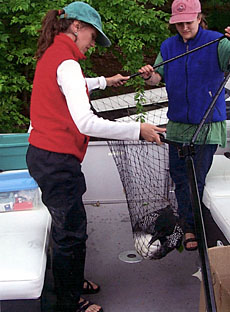
Environmental Quality in the Gulf of Maine
|
||||||||||
|
|
|
|
|
|
||||||||
|
|
|
|
Browse the archive |
|
|
|
|
An interview with Kate Taylor of New Hampshire’s Loon Preservation Committee
By Maureen Kelly
 |
| Kate Taylor (left ) nets a loon for the Loon Preservation Committee’s (LPC) banding program. Photo Courtesy of LPC |
Known for their distinctive black and white checkered breeding plumage and melancholy cries, loons begin their lives lakeside then migrate to the ocean for three to five years to mature. When ready to breed, they return inland—often to the very same lake where they hatched—says Kate Taylor, a wildlife biologist with the New Hampshire Loon Preservation Committee (LPC) of Moultonborough, New Hampshire, which monitors loon populations.
The ability of these birds to live in both freshwater and saltwater environments makes them susceptible to habitat loss due to development and increased recreational pressure inland, lead poisoning from fishing gear, mercury poisoning and oil spills at sea.
Since the Buzzards Bay spill, scientists have been trying to document the event’s impact on loon populations. The carcasses of the dead loons were sent to Tufts University in Grafton, Massachusetts, and the Environmental Protection Agency’s lab in Narragansett, Rhode Island, where researchers will measure bills, wings and other features to determine what breeding populations the birds are from, Taylor says.
To find and track survivors of the spill, the LPC organized a widespread effort among individuals and groups concerned with the preservation of the species. Volunteers and field staff trained their eyes on lakes in the New England states, New York and the Atlantic Canada provinces to watch for oiled birds to show up. Taylor estimates that they monitored about 779 lakes in the Northeast.
She describes the effort as like looking for a “needle in a haystack.” Nevertheless, over a dozen oiled birds were found from southern Massachusetts as far north as Casco Bay, Maine. In Massachusetts, eight loons were rehabilitated and released, though one bird beached again and returned to rehab.
The chances for the long-term survival of these birds are low, however. When a bird is oiled, it can’t preen and its waterproofing is impacted. Oiled birds also tend to be sickly, don’t feed well and can’t compete in the breeding population, Taylor says.
One of the birds spotted in New Hampshire was a female who had been coming back to the same lake since she was banded.
“She was a very experienced bird,” Taylor continues. “When you lose these established, experienced adults it has some serious impacts since only a small percentage of the population breeds—about 20 percent.”
In another tracking study, LPC together with the U.S. Fish & Wildlife Service and other partners are using satellite tagging to investigate loon migratory patterns. Over the last several years, scientists have noticed a drastic decline in the numbers of breeding-age loons at Lake Umbagog in northern New Hampshire.
Little is known about what loons do when they leave their lakes and migrate to their marine wintering grounds. According to Taylor, questions remain as to whether populations stay together, how far south they move and whether birds could be encountering contaminants or other harmful factors at their wintering grounds. Solving these mysteries could provide clues to why the loon populations on Lake Umbagog are declining.